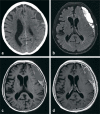Chronic Subdural Hematoma
- PMID: 35236548
- PMCID: PMC9277133
- DOI: 10.3238/arztebl.m2022.0144
Chronic Subdural Hematoma
Abstract
Background: Chronic subdural hematoma (cSDH) is typically a disease that affects the elderly. Neurosurgical evacuation is generally indicated for hematomas that are wider than the thickness of the skull. The available guidelines do not address the common clinical issue of the proper management of antithrombotic drugs that the patient has been taking up to the time of diagnosis of the cSDH. Whether antithrombotic treatment should be stopped or continued depends on whether the concern about spontaneous or postoperative intracranial bleeding, and a presumably higher rate of progression or recurrence, with continued medication outweighs the concern about a possibly higher rate of thrombotic complications if it is stopped.
Methods: In this article, we review publications from January 2015 to October 2020 addressing the issue of the management of antithrombotics in patients with cSDH that were retrieved by a selective search in the Pubmed and EMBASE databases, and we present the findings of a cohort study of 395 patients who underwent surgery for cSDH consecutively between October 2014 and December 2019.
Results: The findings published in the literature are difficult to summarize concisely because of the heterogeneity of study designs. Among the seven studies in which a group of patients on antithrombotics was compared with a control group, four revealed significant differences with respect to the risk of thromboembolic complications depending on previous antithrombotic use and the duration of discontinuation, while three others did not. In our own cohort, discontinuation of antithrombotics (including both plasmatic and antiplatelet drugs) was associated with thrombotic complications in 9.1% of patients.
Conclusion: These findings imply that the management of antithrombotics should be dealt with critically on an individual basis. In patients with cSDH who are at elevated risk, an early restart of antithrombotic treatment or even an operation under continued antithrombotic therapy should be considered.
Figures




References
-
- Yang W, Huang J. Chronic subdural hematoma: epidemiology and natural history. Neurosurg Clin N Am. 2017;28:205–210. - PubMed
-
- Feghali J, Yang W, Huang J. Updates in chronic subdural hematoma: epidemiology, etiology, pathogenesis, treatment, and outcome. World Neurosurg. 2020;141:339–345. - PubMed
-
- Aspegren OP, Åstrand R, Lundgren MI, Romner B. Anticoagulation therapy a risk factor for the development of chronic subdural hematoma. Clin Neurol Neurosurg. 2013;115:981–984. - PubMed
-
- Rust T, Kiemer N, Erasmus A. Chronic subdural haematomas and anticoagulation or anti-thrombotic therapy. J Clin Neurosci. 2006;13:823–827. - PubMed
Publication types
MeSH terms
Substances
LinkOut - more resources
Full Text Sources
Medical

